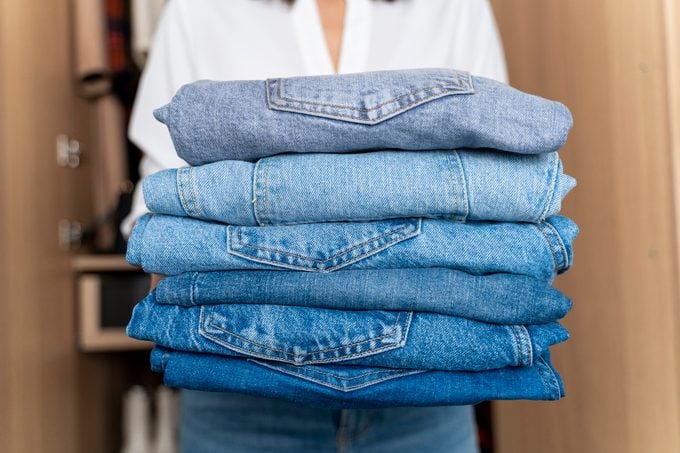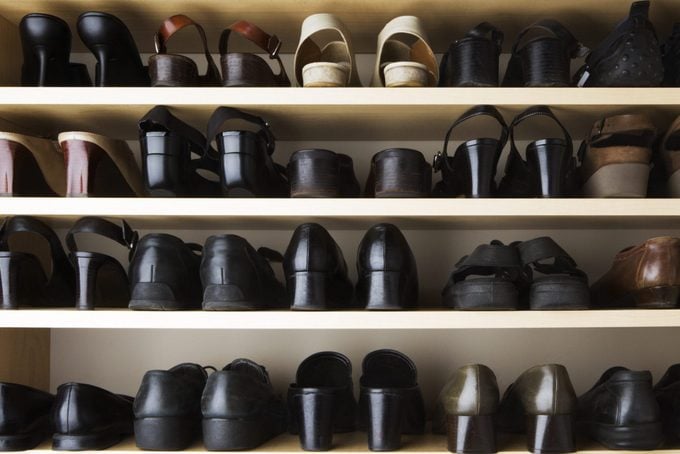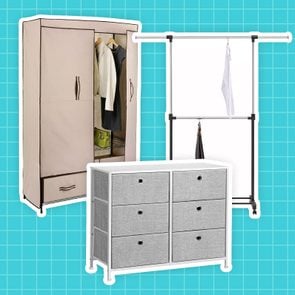15 Secrets for Storing Clothes Fashion Experts Swear By
Updated: Jul. 18, 2023

Get ready for the seasonal clothing rotation drill! We asked experts for quick and easy tips for sorting and storing clothes.
Entering a new season is an exciting time, bringing with it a fresh mindset, an about-face in temperature and a need to swap out the clothes in our closets and make room for the stuff we’re excited to wear. Storing clothes between seasons is more than just a chore—it’s a strategy game. How do you effectively sort, stash and arrange your duds in closet organizers yet keep accessible those items you need for spontaneous vacations or unseasonable weather?
This is where the fashion and organizing experts come in. They have shared their clothes-storage ideas, small-closet ideas, organizing tips and everything else that comes with managing a wardrobe. They’re pros who can teach us tons about how to organize a closet so it actually brings a sense of calm.
“Clothes storage doesn’t have to be a daunting task each season,” says style editor and blogger Kim Naci, who helps clients become masters of their closets. “Learn the ropes, develop a system, and it becomes a simple, almost therapeutic ritual. The peace of mind that follows, knowing that your beloved pieces are protected so you’re reunited for the next season, is priceless.” Put these tips into action, and your wardrobe will be ready when it’s time to pull it out again.
Get Reader’s Digest’s Read Up newsletter for more organizing, cleaning, humor, travel, tech and fun facts all week long.
Devise three clothing categories: keep, change and cut loose
The initial task in the closet switch-over process is sorting. Naci recommends the triage of clothes into three distinct piles. “The ‘keep’ pile is for no-brainer pieces you’ll surely store for the next season,” she explains. “The ‘change’ pile should include clothes that need minor tweaks or alterations, such as a button replaced, hemming or zipper repair—the type of easy fix that’s worth the investment of doing so.”
As for the “cut-loose” pile, Naci says, clothes you haven’t worn this season and those that are beyond repair go here. “Be strict,” she says. “Your clothes should work for you; you shouldn’t work for your clothes. If you’re clinging to an old pair of pants you can only wear with this one certain top that covers where they’re too snug, those pants are not keepers. Your closet needs to be a collection of pieces that you truly love and wear, not a clothing cemetery.”
Consider doing this task quarterly to keep your wardrobe edited and your style relevant, and it will make your seasonal storage project so much easier. “When you start with a manageable collection and aren’t weeding through loads of clothes that no longer serve you, the task of boxing things up isn’t so daunting,” says Jean Prominski, a professional home organizer and owner of Seattle Sparkle.
Take an honest look at what you wear
Understanding your wardrobe habits is key to making smart decisions about storing clothes. Ryen Toft, a pro organizer and founder of Simply Luxe, suggests an easy yet ingenious method. Start with the best hangers lined up in one direction. “Every time you wear an item, turn the hanger around,” she says. “When it comes time to decide what to toss before storing for the season, you’ll have a true sense of what pieces actually work in your wardrobe.”
And those items you spent a fortune on, never wear and allow to take up precious closet space because, well, you spent a fortune on them? “Get rid of them—sell, donate or pass to a worthy friend,” says Naci. “That price tag is causing you guilt you don’t need to confront every day.”
Add joy to the job
Who said organizing has to be a lonely, arduous process? “Your wardrobe audit and seasonal rotation can be turned into a good time,” says Naci. “Yes, believe me. Invite over a friend whose fashion opinion you value and who will tell it to you straight when a piece isn’t doing you any favors, open a bottle of wine and make an afternoon of modeling your clothes and deciding what to stash and what to trash.”
Remember transitional pieces
While doing your three-pile sorting before storing clothes, keep out a few pieces that’ll get you through the odd temperature change (like a cool summer evening), make it easy to pack when traveling to a different climate and keep you comfy on those in-between days when the season is shifting. “Think layers,” says Naci. “I rely on a light cardigan, a long wrap sweater that can double as a coat or blanket on a flight, a lightweight jean jacket and a trench. They’re all items that can work on top of or under your other clothes, especially if you stick to a neutral color palette.”
Donate, repurpose or recycle

Once you’ve identified the items to cut loose, consider how they can best serve the world. “I love Dora Maar, a digital consignment shop for pieces that are in good shape,” says Naci. “Their Closets with a Cause program gives a percentage of proceeds to a variety of causes.”
To pass along your old denim, Cotton’s Blue Jeans Go Green program accepts any brand and condition and transforms the material into products like housing insulation, pet bed inserts and food packaging.
Toft’s go-to for donations is the For Days Take Back Bag initiative: You buy a bag and fill it with clothes from your closet and drawers (think: socks, underwear, sheets, pillowcases, towels, textile scraps, linens, shoes and handbags) and the company handles the recycling—plus reimburses you $20, which you can put toward your next purchase.
Clean what you’re keeping
Throw everything you can into the washer and take the rest to the dry cleaner, advises Naci. “Moths will go for any food particles on dirty clothes,” she says. “Plus, stains and body odor are much harder to remove if they’ve had months to permeate. And just consider how relaxing it will be to unpack the next season and have ready-to-wear items that aren’t moth eaten.”
Naci suggests finding a dry cleaner that doubles as a tailor so you can deal with your cleaning and alterations in one fell swoop. “Make sure once you get your dry cleaning back that you remove and toss the plastic bag,” adds Toft. “The chemicals in the dry-cleaning bags should not be in prolonged contact with your clothes.”
Choose the right containers
The type of container you choose for storage makes a big difference when it comes to maintaining the quality of your clothes and giving you options for where to keep everything. “Do not pack clothes in plastic bags,” warns Naci. “They hold moisture, which invites moths.”
Her bin of choice is the Skubb storage box from Ikea. “They’re large, flat and can be stacked or slid easily under your bed. They’re totally space efficient and practical. They’ll even house your winter coats if you don’t have room for a clothing rack,” she says.
Learn the optimal folding technique
Efficient folding maximizes storage space. “I do a flat fold for bulkier items like sweaters,” says Naci. “Lay your sweater flat, fold the arms across the chest, then bring the bottom corners to the shoulders. This keeps them thin and stackable, and limits the creases and wrinkles.” For pants, she suggests a single fold at the knees.
Here are some other great tips on how to fold clothes to save space.
Think storage order

“When packing your containers, keep your favorite pieces on top,” says Naci. “You’ll be able to grab them easily once hints of the next season start to creep in but you aren’t quite ready to unload the whole wardrobe. And how exciting is it to open up the box in, say, early fall and be greeted by that yummy cashmere sweater? It’s like a welcome-back moment that gets you psyched for hot toddies.”
Label everything
“Digging through a bunch of bins to find an item you packed away but now desperately need is a drag,” says Prominski. “It’s more work on the front end, but putting labels on your containers will save you a ton of frustration, plus having to repack everything later on.”
She also suggests sticking in the container a list of what’s inside each bin or even creating a spreadsheet with the contents of each numbered container for organized tracking.
Pick your storage locations smartly
“The obvious places for storing clothes, like the basement, garage and attic, are not the ideal places,” warns Prominski. “These spots suffer the most from extreme temperature variations, as well as bugs, mice and flooding, which can cause damage.”
She recommends any spare space inside the house: a top shelf in your closet, under the bed or even a climate-controlled storage unit for more expensive items. You can better justify the cost if you store your entire family’s clothes together, along with things like big comforters, snowsuits, winter coats and gear like sleds and skis.
Hang your precious items, if you have the space
If you have extra room in your home, get a zippered storage wardrobe or a clothing protector to hang from a rack, Prominski says. She suggests the Peva Hanging Suit Bag from the Container Store.
She also suggests using wood hangers to hold dresses, silk shirts and coats, and clip hangers if you want to hang pants and skirts (though they’re fine in containers). Just remember: Never hang your sweaters. “The gravity will stretch them out of shape over time,” she says.
Stack your shoes

Clear plastic boxes are ideal for shoes,” says Prominski. “They allow you to easily see what’s inside and can be stacked neatly against a wall in your closet or wherever you have some space.”
When it comes to tall boots, Toft suggests inserting boot shapers or pool noodles to help them keep their shape, then storing them in a large, long plastic stackable bin. “It’s always a good idea to have all your shoes repaired and resoled and, in the case of winter boots, resealed, so next year you’re ready once again,” she says. Check out these other shoe-storage solutions.
Group seasonal gear
“All of your seasonal and sporty gear should stick together,” says Prominski. “For example, gather hats, gloves and scarves in one bin; group all your ski clothes and accessories together in another. When it comes time to use them, you’re not hunting high and low for a missing ski glove.”
Use moisture and moth control
Moisture is a silent destroyer of clothes in storage. Prominski recommends using inexpensive and readily available moisture-absorbing packets designed to be tossed into storage containers. “Just stock up and add them into all your bins to keep clothes dry and in peak condition,” she says.
To keep the moths away, Naci throws cedar blocks or chips into packed clothing containers. “Go for the lavender-scented to make everything smell fresh and lovely when you unpack,” she says.
About the experts
- Kim Naci is a former fashion designer and current stylist who also writes The Style Blog.
- Ryen Toft is a professional organizer and the founder of Simply Luxe, which helps people declutter their lives and learn to be more organized.
- Jean Prominski is a professional home organizer and the owner of Seattle Sparkle, which organizes homes and teaches others the art of organization.



